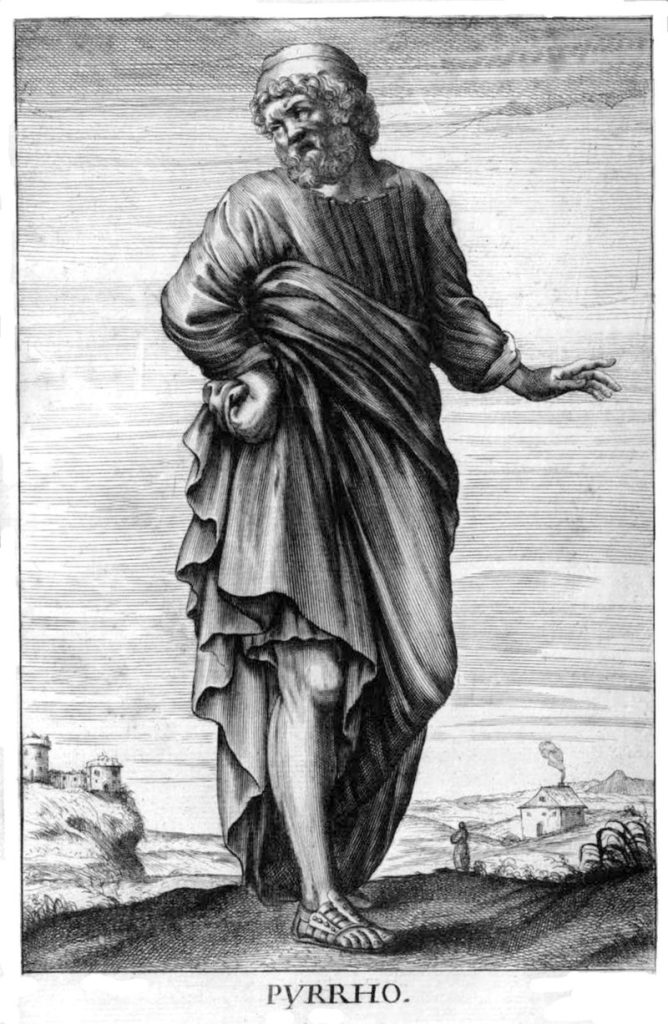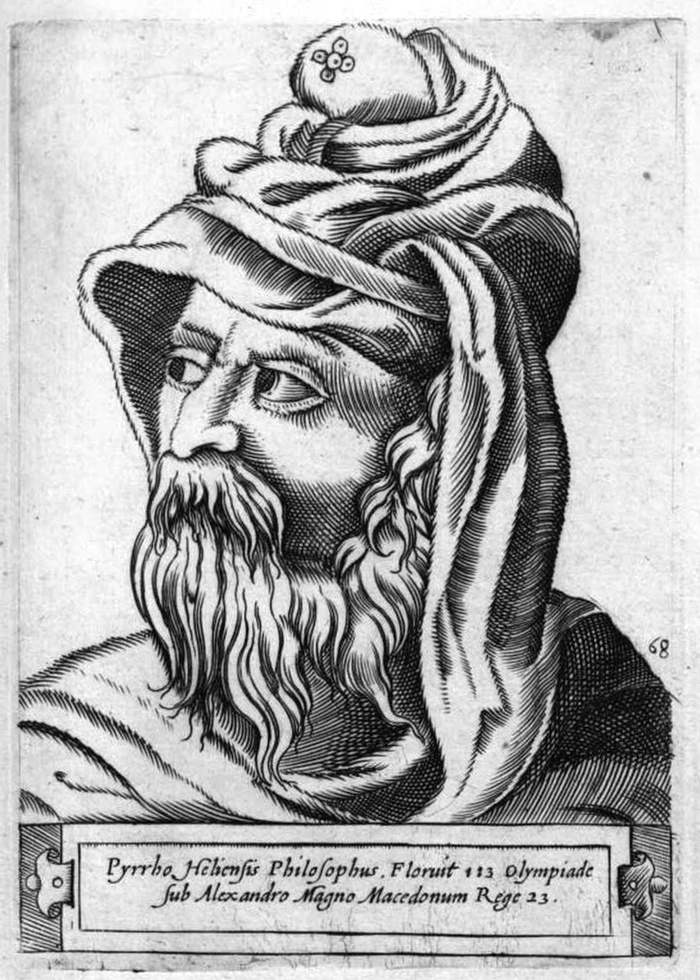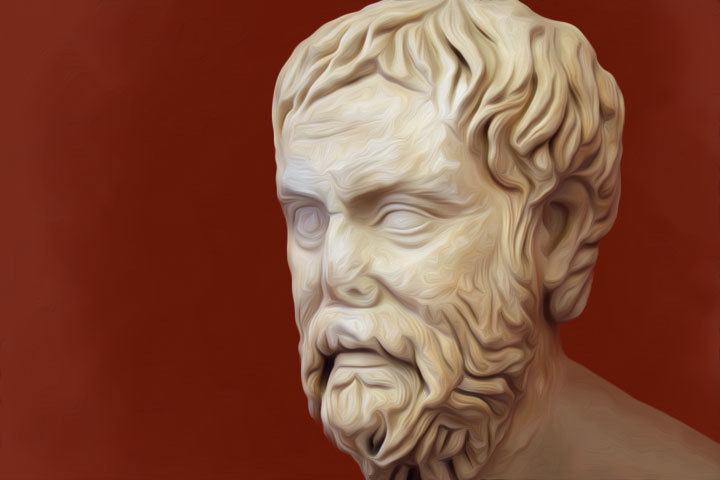Even in antiquity Westerners looked to India for wisdom. The Neoplatonist philosopher Plotinus tried to go there but had to turn back. Some people claim – on scant evidence – that Jesus went there. But there’s only one Westerner from antiquity that we know went to India and brought back something that profoundly influences Western thought to this day.
His name was Pyrrho. He was a priest at the Temple of Zeus at Olympia and a philosopher in the tradition of Democritus. Upon his return to Greece, he became the founder of the philosophy of Pyrrhonism.
Pyrrho successfully made the trip because he was a member of Alexander the Great’s court during
Alexander’s conquest of everything from Greece to India. Alexander had assigned the philosophers in his court to learn everything they could about the philosophies of his newly conquered lands. Pyrrho spent a year and a half in India doing exactly that.
In the 19th Century, when Buddhist texts were starting to become available in European languages, scholars began noticing uncanny similarities between Pyrrhonism and Buddhism. Nietzsche even called Pyrrho “a Buddha.” Eventually, Christopher Beckwith, a philologist specializing in the ancient languages used on the Silk Road connecting trade between the ancient civilizations of the East and the West, proved that Pyrrho had borrowed key ideas from Buddhism.
The most identifiable Buddhist ideas that influenced Pyrrho were nirvana, the Three Marks of Existence, the Three Poisons and their Antidotes, and the idea that the root cause of our mental suffering is delusion – all of which he reshaped to make them compatible with Greek thought.

Pyrrho, ancient Greek philosopher. From Thomas Stanley, (1655), The history of philosophy: containing the lives, opinions, actions and Discourses of the Philosophers of every Sect, illustrated with effigies of divers of them.
On top of this Buddhist philosophical foundation, Pyrrho built an innovative technique. For reasons we can only speculate about, he did not bring back to Greece the Buddhist technique of meditation. Instead, he took techniques that already existed in Greek thought – principally from Democritus, Protagoras, Gorgias, and the Megarians – synthesizing them and repurposing them to achieve ends that meditation achieves.
Nearly all of Western philosophy serves the end of building up the ego. Look at how clever we humans are for figuring all this stuff out! We are as gods!
Pyrrhonism, like Buddhism, is an assault on the ego. To be successful in that assault, Pyrrhonism was built to breach the philosophical conceits of the Western ego.
Pyrrhonism turns rationality against itself. It employs the same tools we use to build up our sense of who we are and what our world is to dismantle those constructions, leaving each of us with what is known in the metaphorical language of Zen as our original face: the face we had before our parents were born.
As a consequence, Pyrrhonism has induced viscerally negative reactions from other philosophers, from antiquity to modernity. The Stoic philosopher Epictetus – famous for urging people to “bear and forbear” – was so riled by Pyrrhonism that he thought Pyrrhonists should be tortured (Discourses Book 2 Chapter 20).

Imaginary engraving of the philosopher Pyrrho of Elis. From the 1580 book Illustrium philosophorum et sapientum effigies ab eorum numistatibus extractae, by Girolamo Olgiati. Reprinted 1583.
In his book, Greek Buddha: Pyrrho’s Encounter with Early Buddhism in Central Asia, Christopher Beckwith demonstrated that Pyrrho translated the Buddhist Three Marks of Existence into ancient Greek and made them the foundation for his teachings.
In Pali, the three marks are known as anicca, dukkha, and anatta. This can be translated into English as saying all conditioned things are impermanent, unsatisfactory, and without self; although how dukkha and anatta should be properly understood and translated is a subject of much debate.
The Greeks were already well familiar with impermanence.
Heraclitus, one of the earliest Greek philosophers, described impermanence with his famous saying: “one cannot step into the same river twice.” Pyrrho chose the Greek word
anepikrita to represent this concept and made it the last in his list of terms. This Greek word not only means “unfixed,” but also means “undecidable” and “unjudgeable,” which point to Pyrrho’s conclusions about the nature of things.
For dukkha, Pyrrho chose the Greek term, astathmēta. Dukkha is commonly translated into English as “suffering,” but the term also points out the nature and origins of this suffering. Dukkha originally referred to the unsatisfactory and unpleasant wheel rotation caused by a faulty axle or axle hole. The term then became applied to the cyclical and unsatisfactory nature of human existence.
Astathmēta reflects this meaning, as it means “unstable” and “unbalanced.” The Greek term felicitously adds the connotation of “unmeasurable” as it was commonly applied with respect to weighing things on balance scales – an object that would become the very symbol of Pyrrhonism – and it points to one of the key concerns of Pyrrhonism: that there is no criterion of truth providing any stable basis for judgment.

Bronze balance pans and lead weights, Vapheio tholos tomb, Laconia. Late Helladic (LH) II (15th c. BCE) National Museum, Athens. Source: InstMC
Pyrrho put his translation of anatta first in his list, perhaps because it so well countered Aristotle’s arguments against Democritus. Buddhist teachings commonly emphasize the personal implications of anatta – that we have no real selves, no soul, nothing that is essentially us. Humans, however, are no special case. No physical thing has those attributes.
Democritus had already pointed to this in his famous saying “by convention sweet and by convention bitter, by convention hot, by convention cold, by convention color; but in reality atoms and void.” In other words, we have no firm basis for knowing that the attributes we agree that objects have are really there. All we really know is that the objects are conditioned things, just as the Buddha pointed out.
Aristotle disagreed with Democritus. He claimed that things do have essences, known now as Aristotelian “substances.” And because things have essences, things can be logically distinguished through what is now known as Aristotelian “differentia” – Latin for the Greek term Aristotle used – diaphora – differences in the essences. Pyrrho translated anatta as adiaphora to negate Aristotle’s claim. There are no diaphora. Things have no metaphysical substance or essence that allows the kind of neat, logical categorizing that Aristotle claims.
Buddhists call this “dependent origination.” The ancient writer, Aulus Gellius, described the same idea in Pyrrhonism, saying “…there is nothing at all that is self-dependent or which has its own power and nature, but that absolutely all things have reference to something else….” (Attic Nights XI, 5, 6-7)

Frontispiece to a 1706 Latin edition of the Attic Nights by Jakob Gronovius
In the Classical era, the Pyrrhonists were always a minority. In the Medieval era, Aristotle’s views would so come to dominate that he would become known simply as “the philosopher.” Indeed, we wouldn’t even have known that Pyrrho based his teachings on the Three Marks of Existence were it not for Eusebius, a Christian apologist who copied Aristotelian arguments against Pyrrhonism from a book by the Peripatetic philosopher, Aristocles of Messene.
Pyrrhonism made a come-back in the Renaissance with the publishing of the works of
the ancient Pyrrhonist philosopher, Sextus Empiricus. This created what was known as the
Crise Pyrrhonienne – the Pyrrhonian Crisis – which put all of existing philosophy into doubt. This attracted many converts to Pyrrhonism, most famously Michel de Montaigne. Afterward, Pyrrhonism fell again into obscurity.
In 1974 the best-selling philosophy book of all time was published: Robert M. Pirsig’s Zen and the Art of Motorcycle Maintenance. In that book the author’s alter-ego, Phaedrus, sides with the Sophists and rails against Aristotle, making a point similar to that which Pyrrho made long ago.
Phaedrus saw Aristotle as tremendously satisfied with this neat little stunt of naming and classifying everything. His world began and ended with this stunt. The reason why, if he were not more than two thousand years dead, he would have gladly rubbed him out is that he saw him as a prototype for the many millions of self-satisfied and truly ignorant teachers throughout history who have smugly and callously killed the creative spirit of their students with this dumb ritual of analysis, this blind, rote, eternal naming of things…the desiccating lifeless voice of dualistic reason.

Depiction of Sextus Empiricus.
Pirsig also pointed out that universities hardly bother to teach ethics today, unlike when he was a student. Yet, people continue to be interested in the pursuit of eudaimonia. Stoicism has come to enjoy a remarkable modern revival. Epicureanism, too, now has many modern adherents. Pyrrhonism seems poised for a similar resurgence, as it represents a reformulation of Buddhist ideas to make them more understandable to Westerners.















3 comments
It’s amazing that the Greeks lived in a world where they were so open to new ideas, even those of their enemies (India), that they were willing to make such ideas part of their lives (back in Greece)
That’s is in sharp contrast with our world where many people have actually became like robots because they are so are so indoctrinated with their dogmas that they cannot even entertain ideas, even if it is modern science, that don’t fit inside their little world, their little book and inside their ravaged and violated minds.
Mental, or intellectual tyranny is probably one of the worst prisons that one can be in…
In anyway, I heard that Alexander III actually decree that he wanted Bhuddism to be spread in Greece.
One actually wondered what Western Society would’ve been like if he had lived longer than he did…
Bhuddism would’ve fitted well into Classical Greece which seemed very open to new ideas because it itself was very open to new ideas.
Contemporary Bhuddism is still very open to new ideas and is one of the religions that do not clash with modern science…
The Abbots of the Shaolin Temple, which is Bhuddist and one of the homes of the martial arts, are buried in tombs that also harbours symbols of the different eras they’ve lived in…
This world would’ve been a much healthier place to live in if Bhuddism, or whatever the Greeks would’ve made from it, became established there…
It’s amazing that the Greeks lived in a world where they were so open to new ideas, even those of their enemies (India), that they were willing to make such ideas part of their lives (back in Greece)
That’s is in sharp contrast with our world where many people have actually became like robots because they are so are so indoctrinated with their dogmas that they cannot even entertain ideas, even if it is modern science, that don’t fit inside their little world, their little book and inside their ravaged and violated minds.
Mental, or intellectual tyranny is probably one of the worst prisons that one can be in…
In anyway, I heard that Alexander III actually decree that he wanted Bhuddism to be spread in Greece.
One actually wondered what Western Society would’ve been like if he had lived longer than he did…
Bhuddism would’ve fitted well into Classical Greece which seemed very open to new ideas because it itself was very open to new ideas.
Contemporary Bhuddism is still very open to new ideas and is one of the religions that do not clash with modern science…
The Abbots of the Shaolin Temple, which is Bhuddist and one of the homes of the martial arts, are buried in tombs that also harbours symbols of the different eras they’ve lived in…
This world would’ve been a much healthier place to live in if Bhuddism, or whatever the Greeks would’ve made from it, became established there…
Maybe Pyrrhonism would also have been a much bigger philosophy…
PJ
TENÍA ALGUNOS CONOCIMIENTOS SOBRE FILOSOFÍA Y FILÓSOFOS, PERO HE DE RECONOCER QUE SUS ARTÍCULOS SON PERFECTOS.
ISIDRO GARRIDO BERMEJO
Trackbacks
Our apologies, you must be logged in to post a comment.